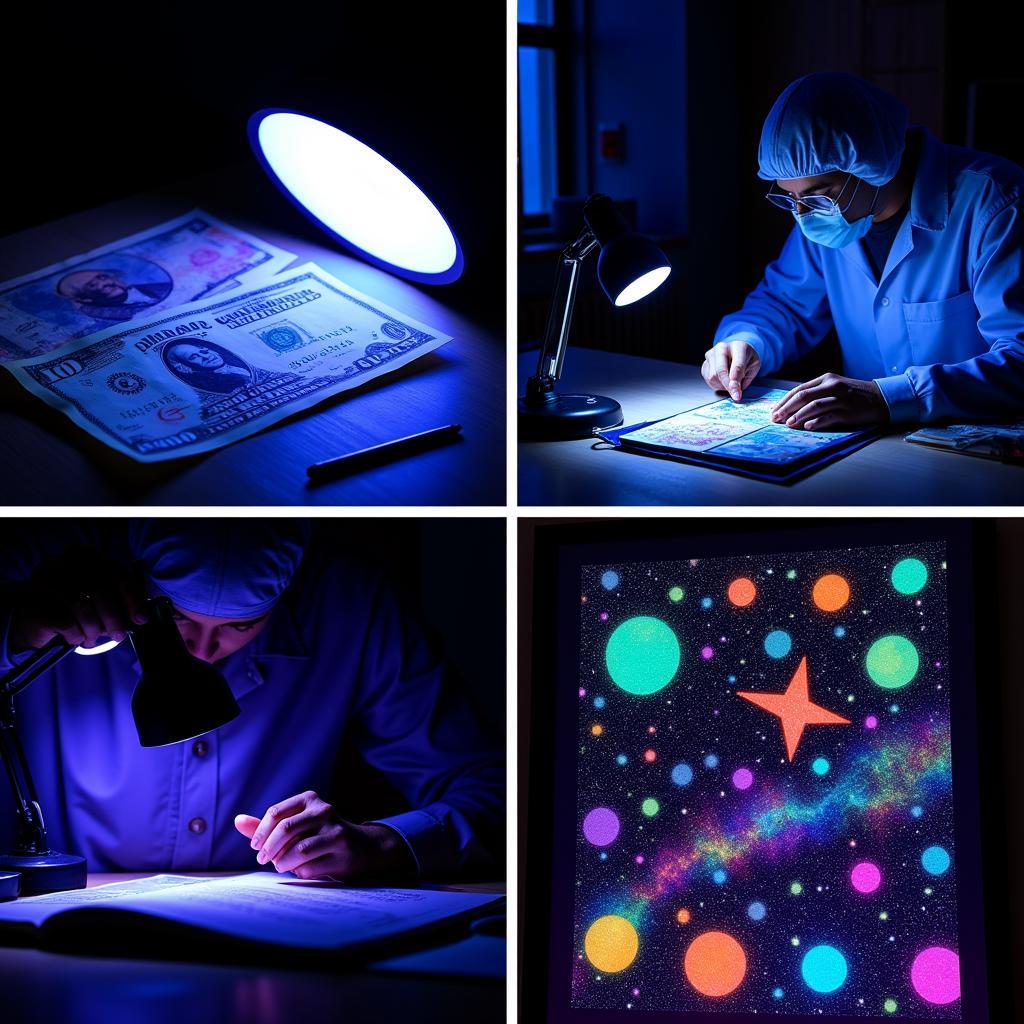Have you ever wondered about the magic of black lights and how they transform ordinary objects into radiant spectacles? It’s all about the fascinating interaction between ultraviolet (UV) light and certain pigments that possess fluorescent properties. These pigments absorb the UV light, invisible to the human eye, and re-emit it as visible light, creating the captivating glow we associate with black lights.
Unmasking the Glow: The Science Behind Fluorescence
Black lights, unlike regular light bulbs, emit primarily long-wave ultraviolet (UV-A) light along with some visible light. When this UV light hits an object containing fluorescent substances, the electrons within those substances get excited and jump to a higher energy level. As they return to their normal state, they release energy in the form of visible light, causing the object to glow. This phenomenon is what we call fluorescence.
What Colors Steal the Show Under Black Light?
While many colors seem to disappear under black light, some take center stage and put on a mesmerizing show. Let’s shed some light on these radiant champions:
-
White: White materials, especially those treated with optical brighteners found in laundry detergents, often glow a vibrant blue-white under black light.
-
Neon Colors: These vibrant shades are specifically designed with fluorescent pigments, making them shine intensely under black light. Think neon green, pink, yellow, and orange.
-
Yellow: Certain yellow objects, particularly those containing fluorescent dyes, can emit a bright, almost greenish-yellow glow.
-
Green: Some green materials, especially those with a yellowish tint, can also fluoresce under black light.
 Objects glowing under black light
Objects glowing under black light
Everyday Wonders: Where Do We Encounter Black Light Fluorescence?
Black lights and the captivating glow they induce are not just confined to nightclubs and amusement parks. They have found their way into various practical applications, highlighting their versatility:
-
Authentication: Black lights are used to verify the authenticity of banknotes, passports, and other important documents. Special security features embedded within these items become visible only under UV light.
-
Forensics: Crime scene investigators utilize black lights to detect bodily fluids, fingerprints, and trace evidence that might not be visible under normal lighting conditions.
-
Art and Entertainment: Black lights create stunning visual effects in artwork, theatrical productions, and themed events, adding an element of intrigue and excitement.
 Various applications of black lights
Various applications of black lights
Expert Insights: A Glimpse into the World of Color and Light
“Understanding the science of color and light is crucial for creating impactful visual experiences,” says Dr. Emily Carter, a renowned color scientist and lighting design consultant. “Black lights, with their ability to induce fluorescence, offer a unique tool for enhancing visual appeal, authentication, and even scientific investigation.”
Unleashing Your Creativity with Black Light Colors
Whether you’re planning a themed party, creating artwork, or simply intrigued by the magic of fluorescence, experimenting with black light colors can be a captivating experience. From neon paints and markers to black light reactive clothing and accessories, the possibilities for adding a touch of luminescence to your life are endless.
Conclusion
Black lights unveil a hidden world of color and fluorescence, transforming the mundane into the magical. From understanding the science behind this phenomenon to exploring its practical applications and creative possibilities, embracing the world of black light colors can be an illuminating and enriching experience.
FAQs About Colors Under Black Light
1. Do all white clothes glow under black light?
Not all white clothes glow under black light. The intensity of the glow depends on the presence of optical brighteners, which are often added to laundry detergents to make whites appear brighter.
2. Can I make my own fluorescent paint?
While it’s possible to experiment with DIY fluorescent paints using tonic water and certain household ingredients, the results might not be as vibrant or long-lasting as commercially available fluorescent paints.
3. Are black lights safe to use?
Black lights emit UV radiation, which can be harmful in high doses or with prolonged exposure. It’s crucial to use black lights responsibly and avoid staring directly at the light source.
4. What is the difference between black light and UV light?
Black lights are a type of UV light that emits primarily UV-A radiation, which is less harmful than other types of UV radiation. However, it’s still important to use caution.
5. Can I use a black light to charge glow-in-the-dark objects?
While some glow-in-the-dark objects can be temporarily “charged” by exposing them to a black light, this is not their primary charging mechanism. Most glow-in-the-dark materials rely on phosphorescence, a different phenomenon than fluorescence.
Need help choosing the right colors for your space? Discover our personalized color consultations: what colors suit me quiz.
Explore the captivating world of color and find your perfect match:
- what colors look good on warm undertones
- what is halloween colors
- what colors go with warm skin tones
- what color are black holes
Need assistance with your color journey?
Contact us at:
Phone: 0373298888
Email: [email protected]
Address: 86 Cầu Giấy, Hà Nội
Our dedicated team is available 24/7 to assist you!
